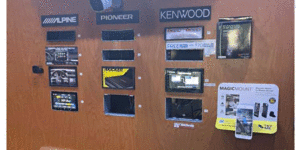Now that a Tier 1 CarPlay radio is a rare commodity, we asked top retailers and distributors when vendors say shortages will ease up.
Some said July/August, some said fall and some said not through the rest of the year. Others, including some of the most prominent industry members, said in all truth, suppliers themselves are unsure and no one really knows.
Tier 2 suppliers such as Epsilon said this: “We were hoping everything after the Chinese New Year [February] would get back to normal and it got worse. Honestly, I don’t know. That’s the scary part,” said Ronnie Brashear, Epsilon VP of Sales. Regarding supply in the fourth quarter of this year he added, “I think it will be a struggle.”
BOSS Audio VP Sales & Marketing Doug Kern said of a shortage end date, “We feel it’s at least six months away if not more. We’re positioning ourselves to expect it through this year. Personally, I feel, come the fourth quarter, it will level out, but the shortages will last for at least six months.”
Some factories in China are not even accepting orders for head units, because they can’t obtain LCD panels, said another supplier.
Some of the supply problems are due to shortages of CD mechanisms, even cardboard for packaging, and, of course, chips.
Car stereo companies are also competing with the likes of Walmart and Amazon for shipping containers that are in very short supply, hence the reason for container costs jettisoning from $1,500 to $10,000.
The Consumer Technology Association recently issued a report on why the chip industry is so constrained. First, it said when you stop or delay an order for chips and then restart it, it can require more than six months to then produce that order. The report said, “The time from ‘wafer start’ at the beginning of a semiconductor production run to finished chips that are ready to ship is measured in months. Thus, the impact of order delays or temporary pauses can be felt for a half year or more.”
 The CTA said chip problems started before the pandemic. For one reason, the chip makers are devoting more of their production to 300mm wafers that are better suited to artificial intelligence and wireless technology and produce greater yields. But most of the demand is still for the traditional 200mm wafers (because they tend to be more stable and cost less). So there are fewer production lines for 200mm wafers at the very time when demand has skyrocketed.
The CTA said chip problems started before the pandemic. For one reason, the chip makers are devoting more of their production to 300mm wafers that are better suited to artificial intelligence and wireless technology and produce greater yields. But most of the demand is still for the traditional 200mm wafers (because they tend to be more stable and cost less). So there are fewer production lines for 200mm wafers at the very time when demand has skyrocketed.
5G phones have 30 to 40 percent more chips than 4G phones.
Advanced Driver Assistance Systems (ADAS) like blind spot sensors are using more chips. Electric vehicles (EVs) require more computing power. Chip demand in cars is expect to grow rapidly over the next 5 years, climbing to 3,000 chips per car, said the CTA report.
Industry is using more chips for things like Internet of Things (IoT) in manufacturing and agriculture. The need for chips for Industrial IoT will double from about 18 billion last year to almost 37 billion by 2025.
Data centers are some of the largest consumers of chips and they are expanding rapidly to support the cloud.
The CTA concludes, “If the current trajectory continues, we will fall short of meeting this demand.”
The report also mentioned Renesas Electronics, which said of the recent fire at its plant in Tokyo, it will take 3 to 4 months to repair. The plant accounts for 30 percent of the global market for microcontroller units used in cars. Two thirds of the chips made at the damaged facility are used by the car industry.
The US share of global chip production in 2019 was 12.5 percent. It is projected to drop to 10 percent by 2030.
The above facts are part of a white paper the CTA is submitting to various congressmen to help them determine how to aid the US chip industry going forward.
The Biden administration has issued an Executive Order investigating US supply chains of chips and how semiconductor manufacturing impacts overall manufacturing. It has proposed investing $50 billion in semiconductor manufacturing and research, as part of the CHIPS for America Act.
By the way, we asked a similar question, “When will chip shortages end,” around this time last year.
Photo: Cartronics, Biscayne, FL
source: https://www.ceoutlook.com/2021/04/20/when-will-radio-shortages-end/

